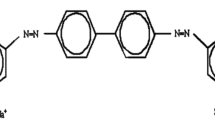Abstract
The present work is aimed at understanding the effect of acid treatment and demonstrating the reason for its effect. For this, Corynebacterium glutamicum biomass was used as a model biomass. Two cationic (cadmium and Methylene Blue) and one anionic (Reactive Red 4) pollutants were used to evaluate the sorption capacity by the biomass. Isotherm experiments showed that acid treatment of the biomass increased the uptake of the cationic pollutants, but decreased that of the anionic pollutant. Through the results of FTIR and potentiometric titrations, it was found that carboxyl groups on the biomass increased after acid treatment. The carboxyl groups seem to be generated likely through hydrolysis of esters in the biomass under the acidic condition. Therefore, increase of the carboxyl groups provided the binding sites for cationic pollutants, whereas it may interfere with the binding of anionic pollutants.
Similar content being viewed by others
References
B. Yu, Y. Zhang, A. Shukla, S. S. Shukla and K. L. Dorris, J. Hazard. Mater., 80, 33 (2000).
P. Nigam, G. Armour, I.M. Banat, D. Singh and R. Marchant, Bioresour. Technol., 72, 219 (2000).
M. Solís, A. Solís, H. I. Pérez, N. Manjarrez and M. Flores, Process Biochem., 47, 1723 (2012).
T. A. Davis, B. Volesky and A. Mucci, Water Res., 37, 4311 (2003).
Z. Aksu, Process Biochem., 40, 997 (2005).
S.W. Won, S. B. Choi, M. H. Han and Y.-S. Yun, Korean Chem. Eng. Res., 43, 542 (2005).
J. Mao, S. W Won, K. Vijayaraghavan and Y.-S. Yun, Chem. Eng. J., 162, 662 (2010).
L. J. Umali, J. R. Duncan and J. E. Burgess, Biotechnol. Lett., 28, 45 (2006).
K. Vijayaraghavna and Y.-S. Yun, Biotechnol. Adv., 26, 266 (2008).
S. K. Mehta and J. P. Gaur, Crit. Rev. Biotechnol., 25, 113 (2005).
E. Romera, F. González, A. Ballester, M. L. Blázquez and J. A. Muñoz, Crit. Rev. Biotechnol., 26, 223 (2006).
D. Kumar and J. P. Gaur, Bioresour. Technol., 102, 2529 (2011).
Y.-S. Yun, D. Park, J.M. Park and B. Volesky, Environ. Sci. Technol., 35, 4353 (2001).
F. Pagnanelli, F. Vegliò and L. Toro, Chemosphere, 54, 905 (2004).
P. Lodeiro, B. Cordero, Z. Grille, R. Herrero and M. E. Sastre de Vicente, Biotechnol. Bioeng., 88, 237 (2004).
J. Mao, S.W. Won and Y.-S. Yun, Ind. Eng. Chem. Res., 52, 6446 (2013).
K. Vijayaraghavan, J. Mao and Y.-S. Yun, Bioresour. Technol., 99, 2864 (2008).
M. H. Han and Y.-S. Yun, Biochem. Eng. J., 36, 2 (2007).
S.W. Won, S.B. Choi and Y.-S. Yun, Colloid Surf. A-Physicochem. Eng. Asp., 262, 175 (2005).
J. Mao, S.W. Won and Y.-S. Yun, World J. Microbiol. Biotechnol., 25, 1259 (2009).
L. H. Velazquez-Jimenez, A. Pavlick and J. R. Rangel-Mendez, Ind. Crop. Prod., 43, 200 (2013).
S. Deng and Y. P. Ting, Environ. Sci. Technol., 39, 8490 (2005).
S. T. Akar, A. Gorgulu, Z. Kaynak, B. Anilan and T. Akar, Chem. Eng. J., 148, 26 (2009).
N. Yee, L.G. Benning, V.R. Phoenix and F.G. Ferris, Environ. Sci. Technol., 38, 775 (2004).
S.W. Won, S. B. Choi and Y.-S. Yun, Biochem. Eng. J., 28, 208 (2006).
F. Pagnanelli, M. Petrangeli Papini, L. Toro, M. Trifoni and F. Vegliò, Environ. Sci. Technol., 34, 2773 (2000).
V. Padmavathy, P. Vasudevan and S. C. Dhingra, Chemosphere, 52, 1807 (2003).
R. Ashkenazy, L. Gottlieb and S. Yannai, Biotechnol. Bioeng., 55, 1 (1997).
S. Schiewer and B. Volesky, in Environmental microbe-metal interactions, D. R. Lovley Ed., ASM Press, Washington, DC (2000).
S. Hunt, in Immobilization of ions by biosorption, H. Eccles, S. Hunt Eds., Ellis Horwood, Chichester, UK (1986).
R. Pratibha, P. Malar, T. Rajapriya, S. Balapoornima and V. Ponnusami, Desalination, 264, 102 (2010).
Author information
Authors and Affiliations
Corresponding author
Rights and permissions
About this article
Cite this article
Won, S.W., Choi, S.B. & Yun, YS. On the reason why acid treatment of biomass enhances the biosorption capacity of cationic pollutants. Korean J. Chem. Eng. 31, 68–73 (2014). https://doi.org/10.1007/s11814-013-0184-7
Received:
Accepted:
Published:
Issue Date:
DOI: https://doi.org/10.1007/s11814-013-0184-7




